That Rolling Stone piece about the secret life of V for Vendetta co-director Larry Wachowski, written by Peter Wilkinson, went up today on the magazine’s website. But the most interesting passage is about their (alleged) creative attitude. Wilkinson quotes entertainment lawyer Eric Feig as saying that the Wachowski’s “[are] not that interested in movies right now. V for Vendetta was set in motion before The Matrix. They’re focusing exclusively on comic books and video games.” Wilkinson adds that “Larry’s own filings in his divorce from Thea Bloom [makes no mention] of new Wachowski brothers scripts in the pipeline.”
Day: January 12, 2006
Horror filmmaker Eric Red (The
Horror filmmaker Eric Red (The Hitcher) killed a couple of people in a West Los Angeles demolition-derby car wreck accident in May 2000. I don’t know what the moral is, but this is one of the weird- est Hollywood-filmmaker-dodges-the-legal-consequences stories I’ve ever read. Written (and very thoroughly reported) by Paul Cullum, it’s in this week’s L.A. Weekly and is called “Death Race 2000.”
This Video Dog/Salon piece may
This Video Dog/Salon piece may seem at first like only a moder- ately amusing parody of Werner Herzog’s Grizzly Man, but hang in there. The payoff comes at the end, and it’s pretty close to hilarious.
Moby is “helping out” with
Moby is “helping out” with the music for Richard Kelly’s Southland Tales, which will be out towards the end of the year, and he’s seen an early edit and here’s what he said about it on his journal: “It’s remarkable….some people will love it and some will hate it. It’s not going to be a movie that allows for ambivalence or indifference, and it’s safe to say that almost no one who sees it will be able to say what it’s about. I love it, and i’m really happy to be working on it.”
Down To It
I finally saw Debra Granik‘s Down to the Bone last night and got the wisdom of what almost every deep-focus movie journalist and critic has been saying since it (barely) opened in New York and Los Angeles nearly six weeks ago, which is that it’s grimly real but has something that doesn’t let up. This is a profoundly honed and life-like low-budgeter about a mom with two kids coping with drug addiction, and Vera Farmiga, who plays this withered young woman like she’s not playing her at all, is the absolute shit.
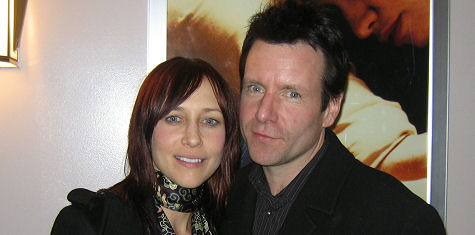
Vera Farmiga, Hugh Dillon after last night’s screening of Down to the Bone at Laemmle’s Music Hall — 1.12.06, 9:50 pm.
Farmiga doesn’t perform — she becomes and burns through. She has the saddest eyes and the posture of a Siberian salt-mine worker, and she makes you feel the empty-soul fatigue of working a job at a supermarket check-out counter while nur- sing a serious cocaine habit and…Christ, stealing birthday money from her son in order to score, and then getting fired after she cleans up because the coke made her work faster.
This is Anna Magnani in Open City reborn and time-tripped into something worse than mere poverty.
I’ve been told Down to the Bone is the main reason Farmiga landed major roles in Anthony Minghella‘s upcoming Breaking and Entering and Martin Scorsese‘s The Departed…you can see why in a heartbeat.
Newsweek‘s David Ansen called Farmiga’s Down to the Bone performance a “revelation” and listed her performance among the best of the year, and of course the L.A. Film Critics voted her their ’05 Best Actress award. It was these responses that stirred me from slumber and led to last night’s wake-up.
I am so late-to-the-party on this one I don’t want to talk about it. But I am and I’m sorry, and I wish I’d been able to say this before: this is a moderately weak year for female performances, and there’s no question that Farmiga’s performance in this bleak but mesmerizing film is absolutely gold standard.

Farmiga with Jasper Daniels (playing her older son) in Debra Granik’s Down to the Bone
If we lived in a world that singled out the real jewels in the rough and paid less attention to industry hype and herd-mentality thinking, Vera Farmiga would right now be breathing down Reese Witherspoon‘s neck.
But of course we don’t and she’s not, and Farmiga, giving it one last shot and laying it on the line, personally arranged for last night’s Down to the Bone screening at Laemmle’s Music Hall (and for guys like me to be invited)…and good for her. And cheers to Adrien Brody, an old friend of Farmiga’s (they co-starred in an ’02 film called Dummy) who dropped by to lend support.
My apologies to publicist Steven Zeller, who tried to get me to see Down to the Bone early last fall. And a respectful tip of the hat to Farmiga’s ICM agent Chris Matthews, who also dropped by to show support and cheer things along.
And hold on…who’s this Hugh Dillon guy? He gives an assured, quietly sexy performance as Farmiga’s drug-counsellor boyfriend who holds her hand and caresses her cheek as they both spiral downward in the third act. Damned if he isn’t another reason for me to feel like a dilletante columnist.

Adrien Brody, Farmiga, Dillon — Thursday, 1.12.06, 9:52 pm.
Dillon is one of those steady souls who comes into a scene and looks the lead actress right in the eye in an easy, friendly way and says it plain and true (like he does in his first scene with Farmiga) and right away you’re saying to yourself, “This guy’s cool…I trust him.”
Dillon should be happening. He should be the star of a TV cop show… something. He’s got that pale-faced Irish hard-guy thing…he should have been cast as a cop or a wise guy in The Departed.
Don’t mention my having missed Down to the Bone at Sundance ’04 — I’m having enough trouble coping as it is. Just take my word and rent it when it comes out on DVD, which will probably happen over the next four to six months.
I told Dillon after the screening that the movie has a unique tension that comes from pulling you in opposite directions. You want his and Vera’s characters to straighten up and fly right and your heart sinks when they fall off the wagon, but at the same time the bleakness of their lives and surroundings seems so futile and spiritually draining that you can understand the appeal of an occasional snort.
Ve detta Days
If one man’s terrorist is another man’s freedom fighter (depending on one’s political perspective), the notion of a “good terrorist” should be an exploitable subject for a Hollywood film…no? In any case it’s now the basis of a very smart big-bolt action drama, and from the makers of The Matrix yet — the brilliant, very crafty, vaguely oddball Wachowski Brothers.
V for Vendetta (Warner Bros., 3.17), which I saw Wednesday afternoon, is a genuinely rousing and serious-minded thriller that’s fairly throbbing with political metaphor. Anyone over the age of 10 or 11 will be able to connect the dots. And it’s probably safe to assume that V will anger a few rightie jerkwads, but that’s fine — March can be a boring month and the arguments will be fun.

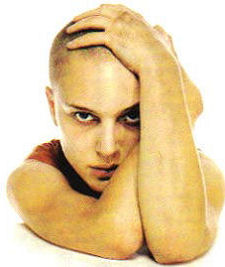
V for Vendetta is Fight Club-plus…it’s Fight Club strapped to a missile…or should I say a fertilizer bomb?
Based on Alan Moore’s early ’80s graphic novel and set in a fascist England in the near-future, it’s about revenge and revolution from the point of view of an anti-fascist rabble-rouser provocateur named “V” (voice-acted by Hugo Weaving, whom we never meet in the flesh). And about a growing relationship between V and Evey Hammond (Natalie Portman), whose parents were crushed for anti-fascist activi- ties and, like Neo at the beginning of The Matrix, is looking to add something vital to her life.
She certainly acccomplishes that before the film is over…along with thousands of others in London who join in overwhelming the police in front of Parliament…each one, like the hero all through the film, wearing a grotesque Guy Fawkes mask… bonding fast against tyranny.
Okay, so it has a pie-in-the-sky, fairy-tale ending. I think that’s allowable in some cases.
Most readers probably know that Fawkes was one of a group of Roman Catholic conspirators who attempted to blow up London’s Parliament building (or perhaps just the House of Lords) in 1605, but didn’t quite succeed. He and his co-conspi- rators were caught and was executed for treason. The anniversay of Fawkes’ failed attempt (which happened on November 5th) is celebrated as Guy Fawkes Day.

V for Vendetta is a futuristic myth, a fable…designed at every stage to entertain but quite obviously aimed at our world and time…portraying what happens when people get scared about potential enemies and give a pass to rightwing brown- shirts who run roughshod over basic freedoms. If you don’t see the parallels to the political tendencies and tensions of 2006 then I don’t know what.
What this is, curiously, is a heavily-budgeted, Joel Silver-produced actioner that works as a kind of companion piece to Eugene Jarecki’s Why We Fight. Jarecki’s film is pure exposition, of course, but it paints a riveting portrait of some crafty politicos who did what they could to exploit citizens’ fears after 9/11 in order to expand and strengthen their power base…and that’s exactly what the bad guys have been up to in Vendetta.
So the film is nervy as hell and will most likely enrage people like Ann Coulter, Bill O’Reilly and Sean Hannity, who will probably say it endorses terrorism or some such hooey. It doesn’t, of course…I mean, not actually…but watch the righties go to town.
Vendetta may not have the stylistic visual pizazz of the Matrix films, and in fact feels a tiny bit flat-footed during the first 15 minutes or so, but this concern quickly falls away because once the film gets rolling it becomes more and more pointed and complex by the minute.
In my book V is one of the most politically audacious mainstream Hollywood films ever made because it really lays it on the line — there are dark echoes of 9.11 and 21st Century neocon power dreams and hard-right fanatacism all through it, and yes…the good guy does blow up a building or two.
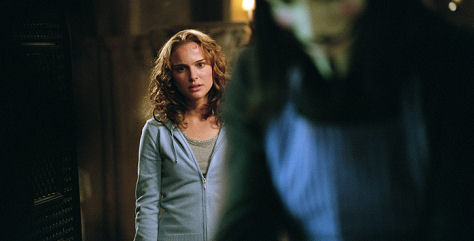
Natalie Portman, Hugo Weaving in V for Vendetta
And yet — trust me — this is a film that says and stands for all the right things. Which is why it’s going to get attacked.
Look at all the inflammables…a terrorist hero, a sub-plot about a deeply-in-love lesbian couple (this plus those hot lezzie scenes in Bound tells you the boys definitely have a thing for girl-on-girl action), plus a huge fertilizer bomb under Parliament and that ’03 sex-change operation…forget it, the right’s going to have a field day.
The bottom line is that V isn’t some simple-minded action flick trying to glorify the struggle of a lone terrorist against a repressive right-wing regime. It’s using a story that follows the contours of an action-thriller to push an allegory about some very real and threatening tendencies in our society today.
James McTeigue “directed” V, but it was basically a Wachowski show and there’s no point in getting picky about this. But it’s probably fair to credit McTiegue for the fact that the actors are excellent from to bottom — Weaving, Portman, Stephen Rea, John Hurt, Stephen Fry, Sinead Cusack, et. al.
I assume Warner Brothers marketing will be handing out Guy Fawkes masks at press and promotional screenings between now and March 17. How could they not be? Can I have mine early so I can be the first one on the block?
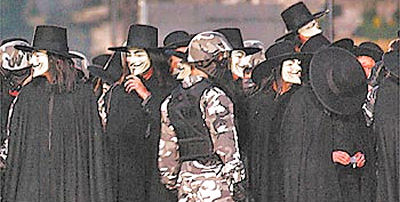
In any case, the Wachowskis are back after a two-year hiatus, and bully for that.
For most of us, the legend of Larry and Andy began nine years and three months ago with the release of Bound, a brilliantly designed indoor crime drama. Their rep was double-certified and cast in industrial steel with the release of The Matrix in March 1999, and it grew from there. For the next four years the Wachowskis were as mythical gods.
But the aura started to fade with the May 2003 release of The Matrix Reloaded, which disappointed just about everyone on the planet except for David Poland, and then came the Really Big Crash of The Matrix Revolutions in November of ’03, and everyone was saying “what happened?” The Wachowskis had let everyone down and all of that geek goodwill pretty much imploded.
The boys seemed to disappear for all of ’04 and early ’05. Then they began work on Vendetta last summer in London and here they are again with a film that some are going to call a work of genius, or at least a piece of revolutionary cinema.
Everybody loves a good comeback. Will V for Vendetta make big money or just good money? No telling…let’s see what happens.
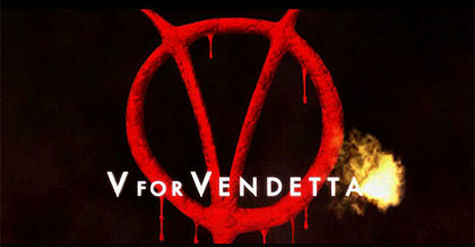
Niagara Falls
Here’s an Abbott and Costello time-out. I’m figuring some of you need a break from terrorism, and I’m also presuming there are lots of under-30 readers who’ve never heard it. It’s an old burlesque classic that all the comics used to do. The Three Stooges did a version of it in a short called “Gents Without Cents.” Abbott and Costello did a “Pokomoko” version in a feature called Lost in a Harem , and then a “Niagara Falls” version with Sid Fields on their 1950s TV series.
Harsh Respect
As long as we’re looking ahead here, I saw David Ayer’s Harsh Times on Monday night, and it left me (or I left it) a little more than pleasantly surprised.
This is a totally respectable hardcase urban drama — perhaps not a date movie (unless you have an X-factor girlfriend or wife who thinks like Manohla Dargis), but it’s quality stuff all the way and rates as a very respectable calling-card film for Ayer, who’s best known for having written Training Day.
It’s not coming out for another three months (Bauer Martinez is planning a smallish mid-April release) but the word on Harsh Times out of the Toronto Film Festival was iffy, and it’s not that. I wouldn’t call it transcendent or drop-your-socks amaz- ing, but it’s pretty damn sturdy and rooted, and extremely well acted by leads Christian Bale and Freddy Rodriguez.
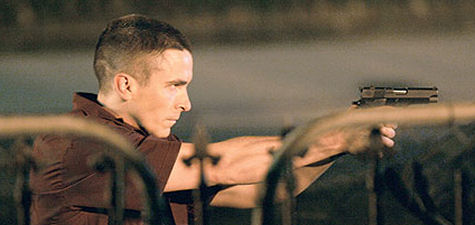 Christian Bale in David Ayer’s Harsh Times
Christian Bale in David Ayer’s Harsh Times Written about ten years ago and clearly cut from the same cloth as Training Day (which Ayer reportedly wrote two or three years after this),
It’s not what anyone would call a pleasant sit, but it has an honest street feeling and is certainly not the kind of film that uses lurid exaggeration for cheap effect.
It’s about a Gulf War veteran who’s obviously a hair-trigger nutjob (Bale), and how he gradually falls apart and detonates over the span of two or three (four or five?) days after failing to land a job as an L.A. policeman force hangin’ and cruising around East Los Angeles with his immature, irresponsible homie (Rodriguez).
The story’s about Bale’s character almost finding a career niche for himself with the Feds after losing out on a job with the L.A. police department, and almost nabbing a chance at happiness with his Mexican girlfriend…and about Rodriguez trying to shuck his drinking inclinations and get a job and fly right so he can hang on to his wife-girlfriend (Eva Langoria) and then…kablooey.
The way you’ve been prepped for a film always affects the way you see that film, especially if you’ve been told “watch out, rough going, my friend walked out,” etc. If the film turns out to be not be quite as gnarly or difficult to sit through as you heard it would be, you tend to come out with a favorable impression.
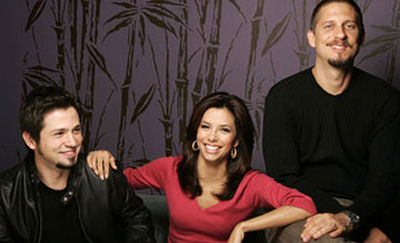
Rodriguez, Longoria and Harsh Times director David Ayer during last September’s Toronto Film Festival.
And if the film accomplishes some worthy things that you weren’t told about in the first place, then you’re really on the boat and flashing all kinds of positive things.
This is what happened to me three nights ago at Raleigh Studios. I went there to see Michael Winterbottom’s Tristram Shandy: A Cock and Bull Story, but when I arrived I learned that Harsh Times was playing next door. Before Shandy began I spoke to a big-name critic who said he’d seen Harsh Times in Toronto and found it overly harsh, and that New York Post critic Lou Lumenick had walked out after ten minutes.
That did it — I was sold. The lights went down and I was quickly bored by Shandy (sorry) so I got up, walked ten steps and slipped into Harsh Times room, and was soon glad I did.
Grabs
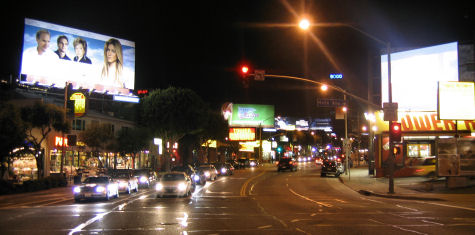
Sunset Boulevard near Horn — Tuesday, 1.10.06, 9:30 pm
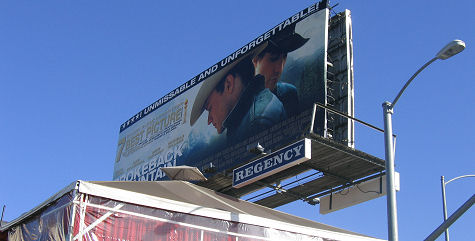

On bike path in Santa Monica — Sunday, 1.8.06, 2:10 pm


Billboard on Laurel Canyon Blvd. just south of 134 on-ramp. Snapped on Tuesday, 1.10.06, 9:50 am.
Reasons to Believe
I spoke last Sunday to director Eugene Jarecki for “Elsewhere Live” about his superb documenary Why We Fight. The Sony Classics release is opening on 1.20 and spreading out from there.
A recording of our chat is uploadable in the Elsewhere Live archive, and here’s a stand-alone version.
If you want some prep before listening, here’s a re-print of a piece I wrote about Why We Fight during the Toronto Film Festival:
A thought hit me when I was writing my column from Toronto on the evening of 9.11.01, but I didn’t have the brass to write it down.

Former U.S. President Dwight D. Eisenhower delivering his farewell speech on 1.17.61.
It was my suspicion that no one in the news media in the coming weeks or months would ever be permitted to explore (or even discuss on a talk show like, say, Chris Matthews’ “Hardball”) what might have motivated the 9.11 attackers to do what they did.
It seemed fairly obvious that the news media were already locked into characterizing the Al Qeada plotters as nothing more or less than harbingers of pure evil, and that allowing for the possibility that United States foreign policy might have had something to do with their anger would simply never be acknowledged.
Eugene Jarecki’s Why We Fight isn’t the first doc to explore why so many people around the world hate our guts, but it’s one of the most precise and persuasive.
This is a cleanly composed, very perceptive explanation of how the American military-industrial complex basically runs everything and everyone, from the U.S. President to the U.S. Congress to the slant of our foreign policy.
The news-clip centerpiece, as you might imagine, is former president Dwight D. Eisenhower’s farewell address warning about the influence of the burgeoning military-industrial complex. Jarecki then goes on to show exactly how prophetic Ike was.
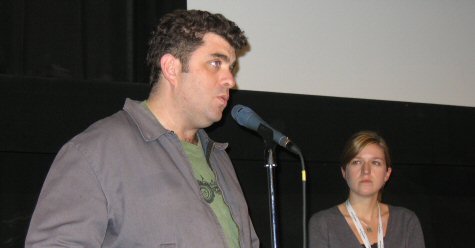
Why We Fight director Eugene Jarecki during q & a following TIFF screening at Toronto’s Cumberland plex — 9.15, 5:50 pm.
This will seem like boilerpate stuff to some, but Jarecki and his sources explain how and why the U.S. decided at the end of World War II to become a permanent roving super-power with the technological ability (if not necessarily the political will) to strike any adversary in any country at any time.
The film’s title is borrowed from a jingoistic Frank Capra doc made during World War II that explained the necessity of defeating Japan and Nazi Germany.
The movie says that for roughly the last 60 years, the U.S. has been led by a basic need for constant military adventurism for the sake of domestic corporate profits, which are then spread around to political supporters in government.
Fight shows how there are four branches of Eisenhower’s complex today — the military, the weapons-making industry, the U.S. Congress and conservative think tanks — and how they all feed into each other.
Gore Vidal is one of Fight‘s talking heads, supplying his view at one point that “we live in the United States of Amnesia.”
But Jarecki is smart enough to stay away from staunch liberals for the most part, speaking mostly to establishment or conservative types such as Sen. John McCain, high-level CIA veteran Chalmers Johnson, William Kristol, Richard Perle, former Lt. Gen. Karen Kwiatkowski and former president Eisenhower’s granddaughter Susan and son John.

Jarecki also talks to the wonderfully candid and articulate Charles Lewis of the Center for Public Integrity, who was more or less the star of Orwell Rolls in His Grave.
Why We Fight is also effective when it talks to average-Joe types. The standout in this realm is an ex-cop named Wilton Sekzer, whose son was killed on 9.11 and who came to embrace a very cynical attitude about the foreign policy aims of the Bush administration, not to mention its general lack of candor about same.
Jarecki also interviews a fresh Army recruit named William Solomon, and to a couple of military pilots who dropped the first bombs in the 2003 invasion of Iraq.
On top of everything else, Jarecki is an excellent cinematographer and editor. The movie is persuasive in part because it’s been shot and cut with eye-pleasing expertise.
